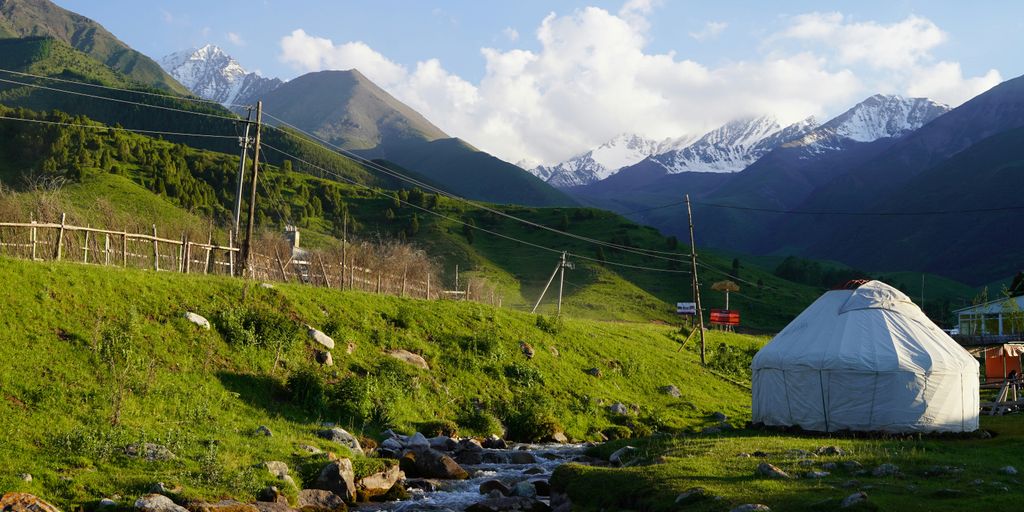Understanding the Difference Between Yurt and Bell Tents: A Comprehensive Guide
Choosing between a yurt and a bell tent for your outdoor adventures can be challenging. Each has its own unique features and benefits, making them suitable for different camping and living situations. This guide will help you understand the key differences between these two types of tents, so you can make an informed decision based on your needs.
Key Takeaways
- Bell tents have a conical shape supported by a central pole, while yurts have a rounded structure with a wooden frame.
- Bell tents are generally easier and quicker to set up, making them ideal for short trips.
- Yurts are more durable and can handle various weather conditions, making them suitable for long-term stays.
- Bell tents are usually more affordable and come in various sizes, while yurts can be customised but are more expensive.
- Bell tents offer more space for families or groups, whereas yurts provide a cosy atmosphere for fewer people.
Origins and Historical Background
The History of Yurts
Yurts have a fascinating history that goes back thousands of years. They originated in Central Asia and were mainly used by nomadic tribes like the Mongols. These portable homes were perfect for the harsh climates of the steppes, providing warmth in winter and ventilation in summer. The design of yurts has stayed pretty much the same over the years, showing just how effective and durable they are.
The Evolution of Bell Tents
Bell tents have a different story. They were first used by the British Army in the 19th century. These tents were designed for quick setup and had spacious interiors to fit multiple soldiers. Over time, bell tents moved from military use to recreational camping and even glamping. You might be surprised to learn that the idea of glamping can be traced back to luxurious tent-living during the 16th century, like the diplomatic summit between Henry VIII and Francis I.
Cultural Significance of Yurts and Bell Tents
Both yurts and bell tents have found their place in different cultures. Yurts are often linked with nomadic lifestyles, while bell tents are now popular in modern camping. Today, you can find them used for everything from family camping trips to luxurious glamping retreats.
Understanding where these tents come from helps us appreciate their unique features and the roles they play in our outdoor adventures.
Structural Differences

Design and Framework
When it comes to the design and framework, yurts and bell tents have distinct characteristics. Yurts are traditionally circular with a wooden frame and a lattice wall structure, providing a sturdy and weather-resistant shelter. Bell tents, on the other hand, have a conical shape supported by a central pole and guy ropes, making them simpler in design but still effective for various weather conditions.
Materials Used
The materials used in constructing these tents also differ significantly. Yurts often utilise natural materials like wood for the frame and felt or canvas for the covering. This makes them not only durable but also eco-friendly. Bell tents typically use heavy-duty canvas, which is waterproof and breathable, ensuring comfort during camping trips or outdoor events.
Space Utilisation and Layout
Both tents offer spacious interiors, but their layouts differ. Yurts generally have a more open floor plan, allowing for better space utilisation. Bell tents, while spacious, have walls that slope inward, which can limit usable space near the edges.
Understanding these structural differences can help you choose the right tent for your needs. Whether you prefer the durability of a yurt or the simplicity of a bell tent, knowing what each offers is essential for a great camping experience!
Assembly and Portability
Ease of Setup for Each Tent
When it comes to setting up, bell tents are a breeze. They’re super easy to put up and take down, which is perfect for anyone who loves to move around. You can usually have it ready in no time, and it folds down neatly into a small bag for easy carrying. On the flip side, setting up a yurt takes a bit more time and effort. If you’re planning to relocate often, a yurt might not be the best choice.
Portability Considerations
Transporting these tents is quite different too. Bell tents are lightweight and compact when packed, making them fit easily into most cars. This is great for spontaneous trips! Yurts, however, are bulkier and heavier, which means they require more space and effort to transport. If you’re thinking about a long-term stay, a yurt could be worth the hassle, but for those of us who like to move around, bell tents are definitely the way to go.
Time and Effort Required
Setting up a bell tent is quick and easy, often taking less than an hour. Yurts, on the other hand, can take several hours to assemble due to their more complex structure. If you’re someone who loves to experience a stylish glamping getaway, the bell tent’s ease of setup and portability make it a fantastic choice.
Usage and Practicality
When it comes to usage and practicality, both yurts and bell tents have their unique advantages. Let’s dive into how each performs in different scenarios.
Camping and Outdoor Activities
Bell tents are a fantastic choice for camping and wilderness activities. They are basic but practical, offering a beautiful natural setting. These tents are lightweight and compact, making them a highly practical solution for hikers. They tackle harsh conditions confidently without giving in to heavy precipitation or high winds. On the other hand, yurts are more suitable for long-term stays and a wide range of climates. They offer a high level of durability, making them ideal for extended outdoor adventures.
Long-Term Living
If you’re considering long-term living, yurts are the way to go. They provide a more permanent and durable structure compared to bell tents. Yurts can withstand various weather conditions and offer a comfortable living space for extended periods. Bell tents, while charming and practical for short-term stays, may require extra protection in inclement weather and are not as durable for long-term use.
In summary, bell tents are perfect for short-term camping and outdoor activities, while yurts excel in long-term living and durability.
Weather Resistance
When it comes to weather resistance, yurts have the upper hand. They are built to withstand harsh weather conditions, including heavy rain and strong winds. Yurts often come with features like rain gutters and snow guards, which help keep them safe and dry. Bell tents, while also capable of handling adverse weather, may not offer the same level of protection and durability as yurts. For long-term use in various climates, yurts are the more reliable option.
Cost and Customisability
Price Comparison
When it comes to cost, bell tents are generally the more budget-friendly option. Here’s a quick comparison of the costs:
| Type | Price Range |
|---|---|
| Bell Tents | £500 – £1,500 |
| Yurts | £3,000 – £10,000 |
As you can see, bell tents are typically more affordable, making them a popular choice for casual campers and glamping enthusiasts.
Customisation Options
Both bell tents and yurts offer a range of customisation options. Bell tents come with various sizes and configurations, allowing you to add personal touches like patterned canvas or custom furnishings. Yurts, while more expensive, can be tailored to meet specific needs, offering a unique blend of style and functionality.
Whether you’re looking for a budget-friendly option or a highly customised living space, both bell tents and yurts have something to offer.
Value for Money
When considering value for money, it’s essential to think about what you need. Bell tents are great for short-term camping and outdoor activities, while yurts excel in long-term living and durability. If you’re someone who loves to experience a stylish glamping getaway, the Bell Tent’s ease of setup and portability make it a fantastic choice.
Comfort and Amenities
Interior Space and Layout
When it comes to interior space, both yurts and bell tents have their own unique advantages. Yurts usually have a circular shape, making the inside feel spacious and open. This is perfect for families or groups who want to hang out together. On the other hand, bell tents come in various sizes. For instance, a 5m family bell tent can be a great option. It often includes a comfortable double bed and two single mattresses, complete with bedding and towels. This means you can have a good night’s sleep without any hassle!
Available Amenities
Comfort is super important when camping. Yurts often come with proper beds and even wood-burning stoves, making them feel more like a home. Bell tents, while simpler, can also be made comfy. You can add rugs, cushions, and even small furniture to make it feel inviting. The flexibility of bell tents allows you to create a space that suits your style and needs.
Insulation and Climate Control
Both yurts and bell tents can be equipped with features to keep you comfortable in different weather conditions. Yurts, with their thicker walls, offer better insulation, making them suitable for colder climates. Bell tents can be fitted with portable heaters or fans to help regulate the temperature. Adding a small, battery-operated fan for warm nights or an outdoor-safe heater for cooler evenings can make a big difference.
Whether you’re planning a weekend getaway or an extended stay, both yurts and bell tents offer a comfortable and spacious environment to enjoy the great outdoors.
Environmental Impact
When it comes to the environmental impact of yurts and bell tents, there are several factors to consider. Let’s break it down into a few key areas.
Sustainability of Materials
One of the first things to think about is the materials used in these tents. Yurts often use natural materials like wood and felt, which can be more sustainable. Bell tents, on the other hand, are usually made from canvas, which is also a natural material but may require more chemical treatments.
Eco-Friendly Features
Both types of tents can have eco-friendly features. For example, some yurts and bell tents come with solar panels for energy. This is great for reducing your carbon footprint while enjoying the great outdoors.
Long-Term Environmental Considerations
In the long run, the environmental impact of these tents can vary. Yurts are often more durable and can last for many years, reducing the need for frequent replacements. Bell tents are also durable but may not last as long as yurts, leading to more waste over time.
Choosing between a yurt and a bell tent can depend on how much you value sustainability and long-term environmental impact. Both have their pros and cons, but either way, you’re making a more eco-friendly choice compared to traditional camping options.
Our planet needs our help, and every small action counts. By choosing eco-friendly options, we can make a big difference. Visit our website to learn more about how you can contribute to a greener future. Together, we can protect our environment for generations to come.
Conclusion
In summary, both yurts and bell tents offer unique benefits that cater to different camping needs. Bell tents, with their simple setup and portability, are perfect for short trips and provide a spacious, comfortable space for families or groups. On the other hand, yurts are built to last and are ideal for longer stays, offering a cosy and durable shelter that can withstand various weather conditions. By understanding the differences between these two types of tents, you can choose the one that best fits your outdoor adventures. Whether you opt for the charming bell tent or the sturdy yurt, both promise a memorable and enjoyable camping experience.
Frequently Asked Questions
What sets a yurt apart from a bell tent?
The main difference is in their structure. A bell tent has a dome shape supported by a central pole, while a yurt features a rounded design with a wooden frame.
Which is better for long-term living, a yurt or a bell tent?
Yurts are generally better for long-term living because they are more durable and can handle various weather conditions.
How easy is it to set up a bell tent compared to a yurt?
Setting up a bell tent is usually much easier and quicker than a yurt, making it ideal for those who move around often.
Can you move a yurt easily?
No, yurts are bulkier and heavier, making them less suitable for frequent relocation compared to bell tents.
Are bell tents more affordable than yurts?
Yes, bell tents are generally more affordable and come in various sizes, while yurts can be customised but are usually more expensive.
What are the main uses for yurts and bell tents?
Bell tents are great for short-term camping and outdoor activities, while yurts are better suited for long-term living and can withstand harsher weather conditions.





